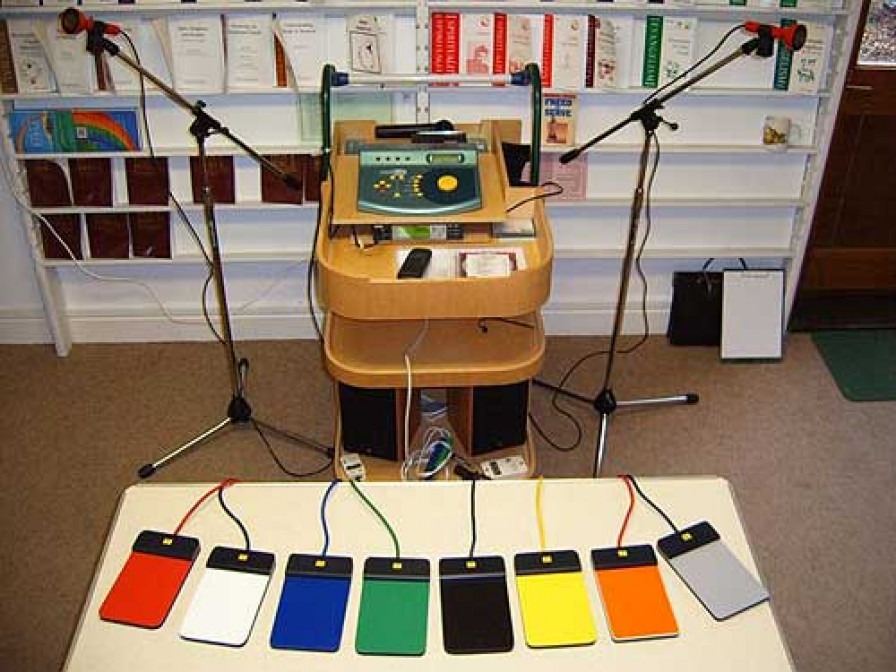A Rough Guide to Assistive Music Technology

Assistive Music Technology can help widen access in Special Educational Needs and Disabled (SEN/D) settings by creating instruments that are uniquely set up to suit the needs of the player. From simple mechanical adjustments to sophisticated computer-controlled sensors, the technology has come on leaps and bounds in the last decade. However, to ensure progression within the field, there is a need for those working with disabled musicians to keep striving for both musical and technical excellence.
Technology has cemented its place with the world of music making, with latest developments often assimilated seamlessly into studio set-ups, instruments and live performances. Musicians, producers and listeners alike readily absorb advances in the sector to exploit the benefits of state of the art music making software, hardware and programming languages. Currently there exists a variety of accessible music making options available to disabled musicians but it still feels like there is a gulf between the latest technologies, and what is available commercially for disabled musicians. With the ever decreasing prices of sophisticated electronics and more electronic musicians taking on the role of programmer, and experimenting with ‘hardware hacking’ as part of their standard practice, is seems the world of assistive music technology is lagging behind because people are afraid of engaging with it.
Perhaps one of the main reasons for this fear is that there is little platform for discussion about how different practitioners and disabled musicians are making the most of what’s on offer. With this in mind, here are a few tips for those looking to broaden their horizons and dip their toes into the assistive music technology world:
- If Assistive Technology is completely new to you, have a look at the recent ‘Engagement with Technology in Special Educational & Disabled Music Settings’ paper. The Executive Summary provides a great insight for those looking to familiarise themselves with the field.
- Don’t undervalue the importance of training – organisations like Drake Music offer training that can teach you how to get to grips with the technology and offer guidelines for good practice. Rolling up your sleeves and having a go is the easiest way to get to grips with assistive music technology!
- Often organisations invest in expensive equipment that is left unused because people are scared to experiment with it in case they break it. Don’t be afraid to have a go – it is unlikely you will cause irreparable damage by pushing a few buttons, and most commercially available gear is surprisingly robust!
- There’s a need for technologies which are intuitive and user-friendly: new innovations using iPads have been very successful in SEN/D settings for this very reason – if you can get hold of an iPad have a look at this list of musical apps.
- The technologies which are designed for SEN/D music making can be very expensive, but some of the same technologies can be found much more cheaply in commercial games consoles. If you have the skills, you can adapt them to do the same job as more expensive equipment! Check out Simon Glenister’s informative blog on using the Kinect if you’re interested in exploring this further.
- In spite of the benefits of bespoke instruments, they can often present extra barriers to participation as their operation and upkeep requires substantial technical know-how. Make sure you keep things simple and start at the bottom and work your way up – progress can be surprisingly quick once you’ve grasped the basics.
- If you are a real technophobe, consider partnering with an organisation who can offer expertise in assistive music technology. If partnership is not feasible, consider splitting the workload in your music making sessions – it is often much simpler to have one music leader running the session, and another operating the music technology.
- Have a look around at what you already have in house – assistive music technology doesn’t have to be expensive or sophisticated – if it improves access to music making then use it! It is considered and consistent application, not complexity of interaction that makes a good piece of assistive music technology. There are also some great pieces of free software available – for example software like Soundplant can quickly turn a PC of Mac keyboard into a sampler, or Audacity, which allows the recording and editing sound files on a computer.
Increasing the dialogue between disabled musicians, music leaders and technology experts is paramount to advance the progress of assistive music technology and should be encouraged at every opportunity. What’s more, it is not just down to the experts to be sharing their knowledge, there is a huge amount to be learned by engaging with colleagues and musicians alike. Engaging in regular reflection, and sharing good practice really is the key to moving forward.
Next month I'll be writing some tips about how to get started integrating assistive technology into your music-making, so why not let us know about your experiences working with assistive music technology? Do you have a Soundbeam gathering dust in a cupboard, or are you working in a setting that regularly makes use of it? Have you found any useful resources to share? It would be great to hear about experiences of what works and what doesn’t!

